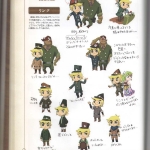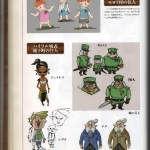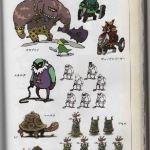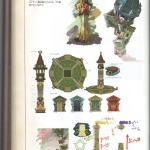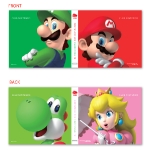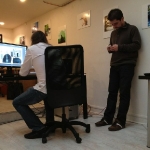01./00. [PS3] Armored Core V
02./00. [3DS] Resident Evil: Revelations
03./00. [PSV] Tales of Innocence R
04./01. [3DS] Mario Kart 7
05./03. [3DS] Monster Hunter 3G #
06./00. [360] Armored Core V
07./04. [3DS] Super Mario 3D Land
08./00. [PS3] The Idolmaster: Gravure For You! Vol. 4
09./02. [3DS] Rhythm Thief & the Emperor’s Treasure
10./07. [3DS] Inazuma Eleven Go: Shine / Dark
11./00. [PSP] Mobile Suit Gundam: Mokuba no Kiseki
12./12. [WII] Just Dance Wii
13./10. [PS3] Warriors Orochi 3 #
14./13. [PSP] Monster Hunter Freedom 3 (PSP the Best)
15./11. [PS3] Final Fantasy XIII-2 #
16./14. [WII] Wii Party #
17./15. [WII] Wii Sports Resort with Remote Plus #
18./19. [3DS] Nintendogs + Cats: French Bulldog / Shiba / Toy Poodle & New Friends
19./17. [WII] Mario Kart Wii
20./16. [WII] Kirby’s Return to Dream Land
L.A. Consumers to Experience New Rhythm-Based Game for the Wii System with Hands-On Demos and Prize Giveaways on Feb. 10
–(BUSINESS WIRE)– Nintendo:
WHAT: Nintendo is teaming up with iam8bit and Giant Robot to invite consumers to celebrate the release of the Rhythm Heaven™ Fever game for the Wii™ console. With its quirky graphics and catchy music, Rhythm Heaven Fever is the perfect game to bring video game fans and art lovers together. This party will be open to the public on a first-come, first-served basis. Attendees will have the chance to get hands-on time with the game in advance of its Feb. 13 release. In addition guests will enjoy game play, food, beverages and music throughout the evening. Attendees can also film and submit clips to be included in a special Rhythm Heaven Fever interactive video experience posted at http://rhythmheaven-jointhegroove.nintendo.com. T-shirts, posters and other premium items customized for the event will be given away while supplies last. Rhythm Heaven Fever is a unique game that lets players find the beat and prove they’ve got the groove. With irresistibly catchy music and quirky graphics, the game puts a new spin on more than 50 easy-to-learn, tough-to-master minigames. More information about Rhythm Heaven Fever is available athttp://rhythmheavenfever.nintendo.com. WHO: California video game fans and music and art lovers of all ages WHEN: Friday, Feb. 10 6-10 p.m. WHERE: iam8bit Gallery 2147 W. Sunset Blvd. Los Angeles, CA 90026 VISUALS:
- Video game fans grooving to the beats of Rhythm Heaven Fever for Wii at a hip L.A. venue
- A photo play set with a backdrop, costumes and props inspired by the game
Source: Nintendo PR
3DS – 84,789
PS3 – 22,924
Vita – 18,942
PSP – 16,008
Wii – 10,396
Xbox 360 – 1,235
DSi LL – 1,180
DSi – 738
PS2 – 713
For comparison’s sake, here are the hardware numbers from last week:
3DS – 80,960
PS3 – 21,155
PSP – 17,181
Vita – 15,219
Wii – 10,173
Xbox 360 – 1,588
DSi LL – 1,200
PS2 – 903
DSi – 822
Access over 5,000 European free-hotspot.com Wi-Fi Hotspots across 21 countries for free via your Nintendo 3DS
1st February 2011 – Nintendo of Europe today announces a new deal with free-hotspot.com, the world’s largest multinational network of exclusively free Wi-Fi Hotspots. The partnership will allow Nintendo 3DS™ owners free access to over 5,000 Wi-Fi hotspots across 21 European countries. Your Nintendo 3DS will automatically* connect to free-hotspot.com’s network in many of the biggest fast food restaurants and leading hotel chains across Europe including McDonald’s, Burger King, KFC, Subway, Ibis Hotels and Etap Hotels.
It’s never been simpler to connect your Nintendo 3DS to the internet. Your Nintendo 3DS will automatically search for and connect to the internet via free-hotspot.com’s access points across Europe.
Guild 01 is Level-5’s new 3DS title contains four different games with contributions from Goichi Suda, Yoot Saito, Yasumi Matsuno, and comedy group America Zarigani’s Yoshiyuki Hirai.
Crimson Shroud is Matsuno’s game. Details on this have been light, but the latest issue of Famitsu has a little bit of new information.
The magazine makes note of the following:
– Tactical RPG
– Success of your moves is partially determined by dice roles
– Has a story component
– Story is presented in the form of a text-style adventure
– First screenshots shown in the magazine
We’re still waiting on some scans (or direct-feed screenshots). We may have some images to share with you later today.
Thanks to 4Him for the tip!
01. [PS3] Armored Core V
02. [3DS] Resident Evil: Revelations
03. [PSV] Tales of Innocence R
04. [3DS] Monster Hunter Tri G
05. [3DS] Mario Kart 7
06. [360] Armored Core V
07. [3DS] Super Mario 3D Land
08. [PS3] The IdolM@ster: Gravure For You! Vol. 4
09. [3DS] Rhythm Thief & The Emperor’s Treasure
10. [3DS] Inazuma Eleven GO
Unlike the past couple of months, only two new digital rewards have been added to Club Nintendo. January’s prizes have been swapped out for Art Academy: First Semester (150 coins) and Mario Party 2 (150 coins).
That’s a little disappointing, but on the bright side, you can also order a “3DS Game Card Case” for 250 coins. The case can hold up to 18 3DS or DS cartridges and it comes with four double-sided covers.
You can find a few photos of the 3DS Game Card Case above and a few additional details here.
You might be wondering why Hironbu Sakaguchi is in some of these photos. Sakaguchi is in Europe for The Last Story’s launch. The game arrives on February 24.
I suppose Sakaguchi thought it’d be fun to visit Nintendo’s Paris Studio and take some pictures!
